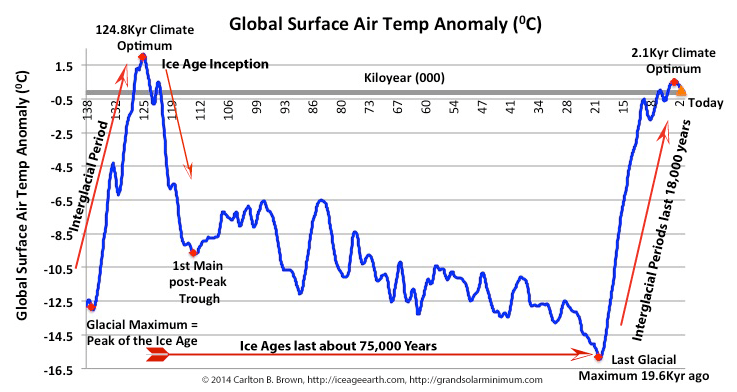During the last 1 million years the average glacial cycle has lasted for 92,900 years, the average interglacial period was 18,200 years long, and the interglacial temperature rose on average 13.50C (global data). The average glacial period, or period of freezing, lasted about 74,700 years, from the climate optimum to the next glacial maximum.[i]
Each glacial cycle displays recurring phases and common points of reference such as a climate optimum, a glacial maximum, an interglacial period, and a first main trough after the climate optimum. Interglacial periods are warming phases that extend from the glacial maximum (i.e., peak of the ice age) to the climate optimum. The glacial maximum represents the lowest temperature of the glacial cycle, during which the maximum ice mass and lowest sea levels exist. A climate optimum represents the highest temperature period of the glacial cycle at the end of the interglacial period, during which ice mass is at its lowest and sea level is at its highest. Ice ages start after the climate optimum.
Click on this page and download a free copy of my book “Revolution: Ice Age Re-Entry,” and read more about this topic in Chapter 3.
[i] Bintanja, R. and R.S.W. van de Wal, “North American ice-sheet dynamics and the onset of 100,000-year glacial cycles.” Nature, Volume 454, 869-872, 14 August 2008. doi:10.1038/nature07158. National Centers for Environmental Information, NESDIS, NOAA, U.S. Department of Commerce. Global 3Ma Temperature, Sea Level, and Ice Volume Reconstructions. https://www.ncdc.noaa.gov/paleo-search/study/11933. Downloaded 10/27/2015.



Can you please advise the data source for the global surface air temperature anomaly graph?
Its there in the paragraph under the figure. But i hear you and am in the process of modifying my graphics to state the data source and ability to use these images without copyright infringement on the graphic. Thanks for the prompt. Bintanja, R. and R.S.W. van de Wal, “North American ice-sheet dynamics and the onset of 100,000-year glacial cycles.” Nature, Volume 454, 869-872, 14 August 2008. doi:10.1038/nature07158. National Centers for Environmental Information, NESDIS, NOAA, U.S. Department of Commerce. Global 3Ma Temperature, Sea Level, and Ice Volume Reconstructions. https://www.ncdc.noaa.gov/paleo-search/study/11933. Downloaded 10/27/2015.